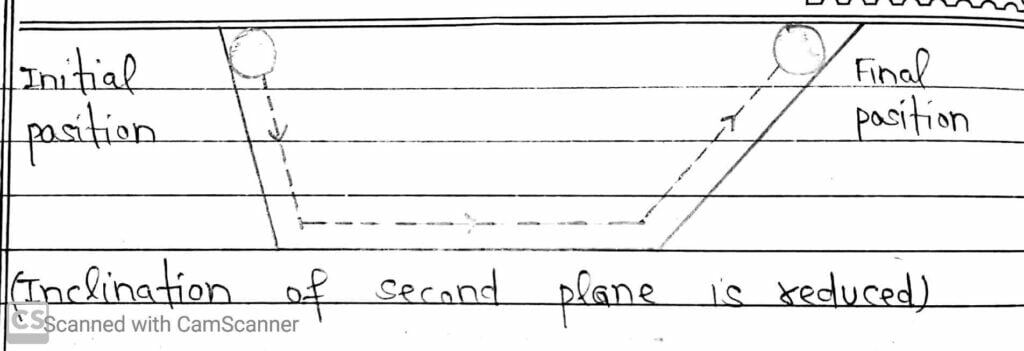Galileo first asserted that objects move with constant speed when no external forces act on them. He arrived at this revolutionary conclusion on the basis of following simple experiments.
(a) Galileo’s Experiments With Single Inclined plane
Galileo first studies the motion of objects on an inclined plane he observed that
(I) When an object moves down on inclined plane, its speed increases.

(II) When the object is moved up on the inclined plane, its speed decreases i.e retards.

(III) When an object is moving on a horizontal plane, there should be no acceleration nor retardation i.e constant speed.

(b) Galileo’s Experiments On Two Inclined Planes Combined Together
Galileo concluded another experiment by using a double inclined plane.
(I) When an object rolls down on the inclined plane, it climbs up the other. It almost reaches the same height but not completely because of friction. In ideal case, when there is no friction, the final height of the object is same as the initial height.

(II) When the slope of the second inclined plane is decreased, the object still reaches the same final height but the object has to travel a longer distance to attend the same height.

(III) When the slope of the second inclined plane is made zero, the object travels infinite distance in the ideal situation.

From his experiments, Galileo concluded the Law of Inertia and state that “The state of rest and the state of motion with constant velocity are equivalent in the absence of external forces”.
Inertia
The terms Inertia means resistance of any physical object. It is defined as the inherent property of a material body by virtue of which it remains in its state of rest or of uniform motion in a straight line.
The various types of inertia are as below
(I) Inertia Of Rest
It is defined as the tendency of a body to remain in its position of rest.
Example: A person standing on a bus falls backward when the bus suddenly starts moving forward.
(II) Inertia Of Motion
It is defined as the tendency of a body to remain in its state of motion in a straight line.
Example: When a moving bus suddenly stops or apply the brakes, a person standing in it falls forward.
(III) Inertia Of Direction
It is define as inability of a body to change by itself it’s direction of motion.
Example: An umbrella protects us from rain.
NCERT Class 11 Physics Book PDF Free Download
Also Read
SL Arora Class 11 Physics Book PDF Free Download
All In One Arihant Class 11 Physics Book PDF Free Download
Arihant All In One Chemistry Class 11 Book PDF Free Download
NCERT Class 11 Physics Hand Written Notes Chapter-Wise
Chapter-1 (Physical World) PDF Free Download
Chapter-2 (Units and Measurement) PDF Free Download
Chapter-3 (Motion In A Straight Line) PDF Free Download
